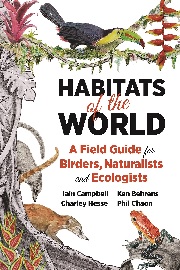Habitats of the World: A Field Guide for Birders, Naturalists and Ecologists

Iain Campbell, Ken Behrens, Charley Hesse and Phil Chaon
Princeton University Press, £28.00
Explaining the ecology of 189 habitats in a handy guide is a tall order. Why do we have conifers dominating in one place, deciduous trees in another, grasslands in some places and deserts elsewhere? While I can’t imagine anyone carrying this ‘field guide’ into the landscape to identify the habitat around them, in reality it is perfect as a pre-field guide, providing much of the initial research you would want to do before travelling to see nature in an unfamiliar part of the world.
The authors mention in their introduction the brutal editorial decisions that were required, but in many respects they chose well. Grouping the habitats by region will make more sense to the traveler, although it does lead to repetition as similar habitats occur in different regions. There is a mammal and bird bias but it’s pragmatic, since birders must be the main target audience. The authors should be very pleased with the overall result - there is sufficient detail for most, and it even names the characteristic avifauna to look out for.
Aside from the armchair travel delight, there are many things to enjoy in this book. I especially liked the excellent habitat photographs and the brilliant habitat silhouettes which give a quick idea of what the habitat looks like and a sense of scale against a human figure. Ecologists may be a little frustrated with the use of local plant names (scientific names are given at the end, but they are not indexed). Nevertheless, Habitats of the World tempted this ecologist to get out into the world to visit some of them!
Dr Ian Powell


